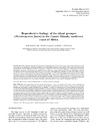Please use this identifier to cite or link to this item:
https://accedacris.ulpgc.es/handle/10553/6247
| Title: | Reproductive biology of the island grouper (Mycteroperca fusca) in the Canary Islands, northwest coast of Africa | Other Titles: | Biología reproductora del abade (Mycteroperca fusca) en las Islas Canarias, costa noroeste de África | Authors: | Bustos-Leon, Rocio Luque-Escalona, Angel Pajuelo, Jose G. |
UNESCO Clasification: | 2401 Biología animal (zoología) | Keywords: | Mycteroperca fusca Island grouper Sex change Maturity Abade, et al |
Issue Date: | 2010 | Journal: | Scientia Marina | Abstract: | This is the first time that the reproductive characteristics of Mycteroperca fusca have been analyzed over the whole area of its distribution, using the parameter of the histological analysis of the gonads. This species is a protogynous hermaphrodite with a marked predominance of females (1:4.9). The males and females displayed marked differences in the distribution of the sizes. The females were distributed over all the size ranges analyzed (229-725 mm total length), whereas the males were observed within the larger sizes, as of 428 mm. One transitional specimen (610 mm total length) was observed.\nThe size at which the females first reached sexual maturity was 335 mm total length whereas the size at which 95% of females reached sexual maturity was 398 mm total length. The average size at which 50% of the females had inverted to the male condition was found to be 678 mm total length. The range of sizes at which the process of sexual inversion took place was broad, between 428 and 725 mm total length. The reproductive period was long, almost covering the annual cycle, although the maximum activity was observed between April and October, with a peak in spawning in June-July. Este es el primer estudio que aborda las características reproductoras de Mycteroperca fusca, en toda su área de distribución, utilizando el estudio histológico de las gónadas. La especie se caracteriza por un hermafroditismo proterogínico.\nExiste una marcada predominancia de las hembras (1:4.9). Los machos y las hembras muestran marcadas diferencias en la estructura de tallas. Las hembras se distribuyen en todo el rango de tallas analizado (229-725 mm de longitud total) mientras\nque los machos sólo fueron observados en las tallas superiores, por encima de los 428 mm de longitud total. Se analizó un ejemplar intersexual de 610 mm de longitud total. La talla a la cual las hembras alcanzan la madurez sexual es 335 mm de longitud total, mientras que la talla a la cual el 95% de las hembras se consideran maduras es 398 mm de longitud total. La talla media a la cual el 50% de las hembras han invertido a la condición de macho fue 678 mm de longitud total. El rango de tallas en el que el proceso de inversión sexual tiene lugar es amplio, entre 428 y 725 mm de longitud total. El periodo reproductivo es amplio, cubriendo casi el ciclo anual completo, aunque el máximo de actividad se localiza entre los meses de abril y octubre, con un máximo de puesta en junio-julio. |
URI: | https://accedacris.ulpgc.es/handle/10553/6247 | ISSN: | 0214-8358 | DOI: | 10.3989/scimar.2010.74n3613 | Source: | Scientia Marina [ISSN 0214-8358], v. 74 (3), p. 613-619 | Rights: | by-nc-nd |
| Appears in Collections: | Artículos |
Items in accedaCRIS are protected by copyright, with all rights reserved, unless otherwise indicated.
